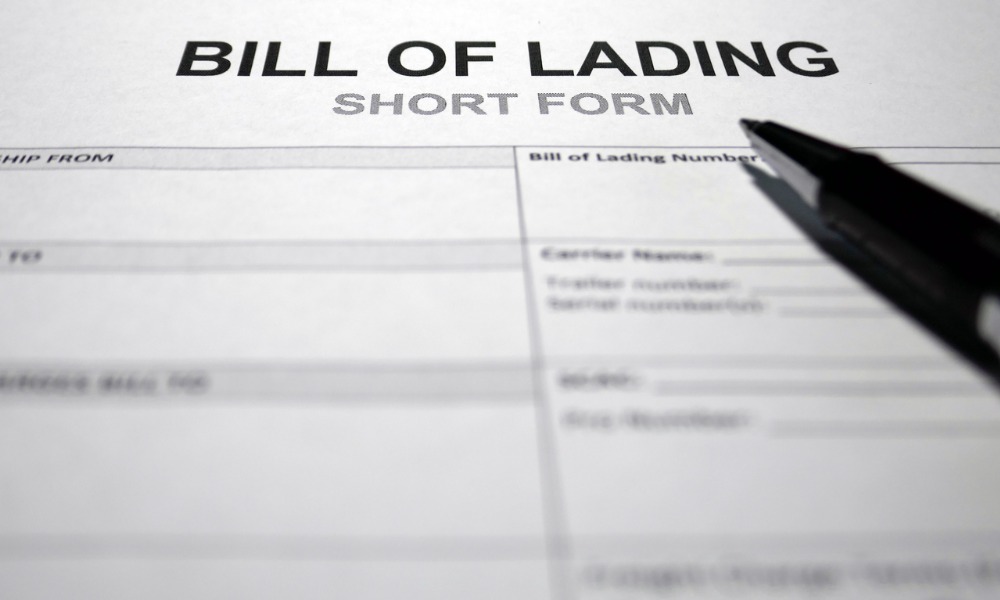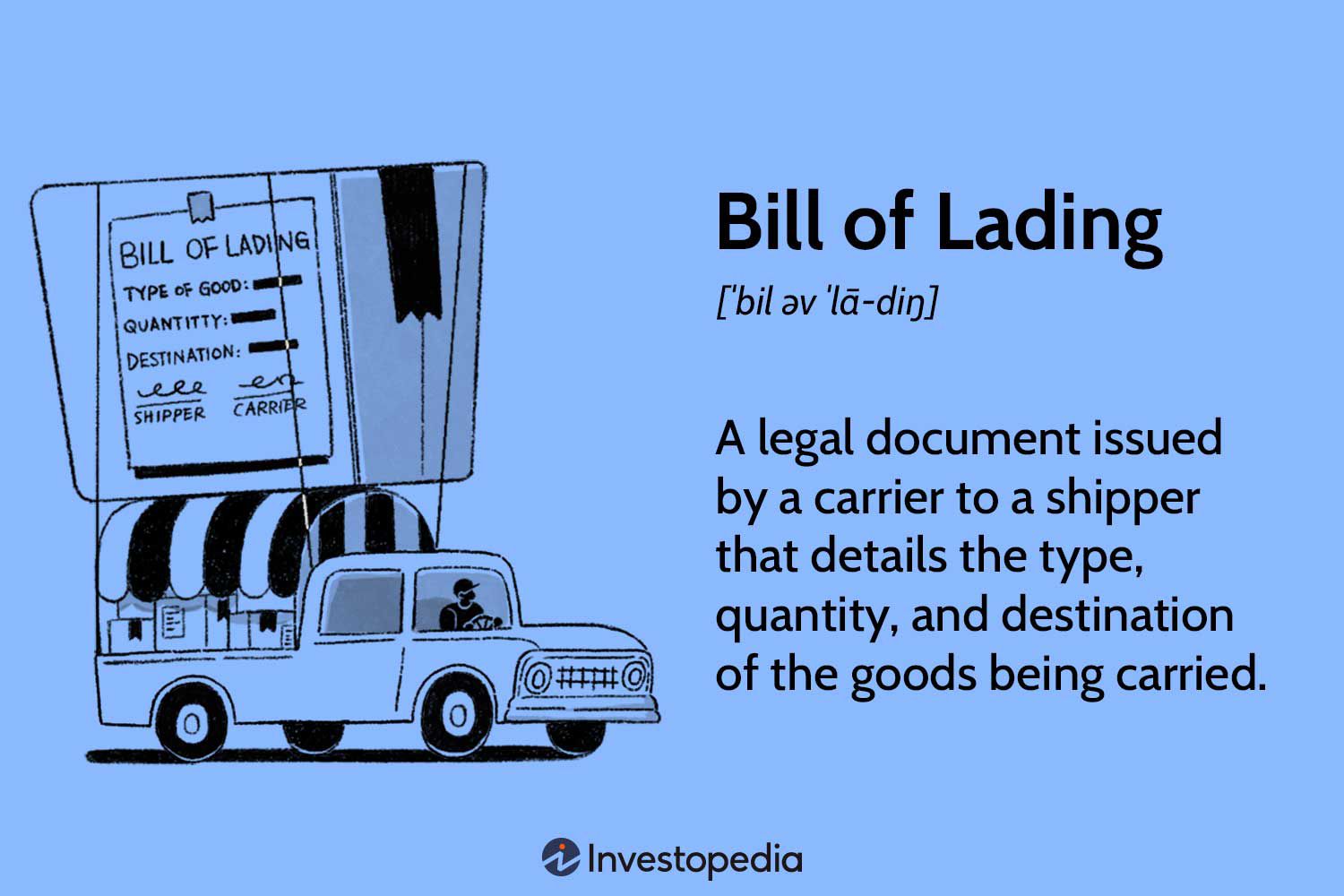In today’s complex global shipping environment, understanding the role of the bill of lading is more critical than ever for shippers, carriers, and logistics professionals alike. As 2025 ushers in new technologies, regulatory changes, and heightened supply chain demands, the bill of lading remains a foundational document that ensures the smooth, secure, and legal movement of goods across borders and through various transport modes.
Whether you are shipping by truck, rail, ocean, or air, the bill of lading is your key to unlocking a hassle-free shipping process. This document is not only a contract between the shipper and carrier but also serves as a receipt for the goods, and in many cases, a document of title—making it indispensable for ownership and legal rights during transport.
What Is a Bill of Lading and Why Does It Matter in 2025?
At its core, a bill of lading is a legal document issued by a carrier to a shipper that details the type, quantity, and destination of the goods being transported. It functions as proof that the carrier has received the goods as described and agrees to transport them to the designated destination.
In 2025, the importance of the bill of lading cannot be overstated because it acts as:
- A contract of carriage: binding the carrier and shipper under agreed terms.
- A receipt of goods: confirming the carrier’s acceptance of the cargo.
- A document of title: enabling the transfer of ownership while the goods are in transit.
Understanding these roles helps shippers avoid costly disputes, delays, and compliance issues. With global trade volumes rising and logistics channels becoming more integrated, the bill of lading is a critical document that facilitates transparency, accountability, and trust in the supply chain.
The Evolution of the BOL in Modern Shipping
The BOL has evolved significantly from its traditional paper form to embrace digital formats in 2025. The transition to electronic bills of lading (eBOLs) offers numerous advantages such as faster processing, improved accuracy, and enhanced security.
Digital BOL systems are helping shippers and carriers streamline documentation workflows, reduce errors, and ensure compliance with international trade regulations. However, despite digital advancements, the fundamental legal importance and functions of the BOL remain unchanged.
In Canada and globally, legislation continues to adapt to recognize electronic bill of lading formats, making it easier for businesses to adopt modern shipping practices while maintaining the document’s legal validity.
Key Types of BOL Every Shipper Should Know
In 2025, shippers encounter several types of bills of lading tailored to different shipping needs and contractual arrangements. Each type serves a unique purpose and understanding their differences is vital for effective freight management.
- Straight BOL: Non-negotiable, used when goods are consigned to a specific recipient.
- Order BOL: Negotiable and can be endorsed or transferred, often used in international trade where ownership changes during transit.
- Bearer BOL: Similar to order bills but transferable by delivery, offering flexibility in ownership transfer.
- Through BOL: Covers multiple modes of transportation under one contract, especially relevant in intermodal shipping.
- Electronic Bill of Lading (eBOL): The digital version that facilitates paperless shipping processes.
Each of these types has distinct implications on liability, ownership, and delivery, so shippers must choose the right bill of lading to match their shipment’s requirements.
Why Accuracy in the BOL Is Critical for Shippers
The bill of lading contains detailed information such as the description of goods, quantities, packaging type, and shipping instructions. Accuracy in this document is essential to avoid disputes or delays in customs clearance and delivery.
In 2025, carriers, customs officials, and logistics providers rely heavily on the information provided in the bill of lading to track shipments, assess duties and tariffs, and ensure compliance with international trade laws.
Errors or omissions can lead to costly fines, cargo detention, or even loss of legal protections in case of damage or theft. Therefore, shippers must meticulously verify every detail on their bill of lading before finalizing the document.
The BOL and Its Role in Cross-Border Shipping Compliance
For Canadian shippers engaged in international trade, the bill of lading is a vital document in meeting customs and regulatory requirements. It serves as proof of shipment and is used by customs authorities to validate cargo contents, origin, and destination.
In 2025, customs agencies increasingly demand electronic documentation, and the bill of lading must be integrated with other shipping documents such as commercial invoices and packing lists to streamline border clearance.
Understanding the regulatory landscape around the bill of lading ensures that shipments avoid delays at the border, reducing demurrage charges and maintaining supply chain reliability.
How the BOL Protects Shippers’ Legal Rights
The bill of lading is not just paperwork—it provides legal protection and clarity on the responsibilities of carriers and shippers. It defines the terms of carriage and helps resolve disputes related to lost, damaged, or delayed goods.
In 2025, with increasing complexity in shipping routes and modes—especially with the rise of intermodal freight—the bill of lading safeguards shippers’ interests by clearly outlining liabilities and claims procedures.
Businesses that fully understand the legal weight of the bill of lading can proactively manage risks and negotiate favorable contract terms with carriers and logistics providers.
Tips for Shippers to Manage BOL Effectively in 2025
To maximize the benefits and minimize risks associated with the bill of lading, shippers should:
- Ensure all shipment details are accurate and complete on the bill of lading.
- Understand the specific type of bill of lading used and its implications.
- Utilize electronic bill of lading solutions to speed up processing and reduce errors.
- Work closely with carriers and freight forwarders to verify documentation compliance.
- Keep a copy of the bill of lading for legal and auditing purposes.
By following these best practices, shippers can streamline their shipping operations, enhance supply chain transparency, and avoid costly delays or disputes.
Why Partnering with Experienced Logistics Providers Matters
Given the critical role of the bill of lading, partnering with logistics experts who understand its nuances is essential. Professional providers can assist in preparing accurate documents, choosing the appropriate bill of lading type, and leveraging technology to optimize shipping workflows.
In 2025, companies like RailGateway stand out as trusted partners to help Canadian shippers navigate the complexities of bill of lading management. Their expertise ensures shipments comply with all legal and regulatory requirements while delivering efficient, reliable freight transportation.
The Bill of Lading – Your Shipping Backbone in 2025
In summary, the bill of lading remains an indispensable document in the shipping ecosystem, carrying legal, contractual, and operational significance. Its proper management is crucial for ensuring goods move smoothly, ownership transfers correctly, and liabilities are clearly defined.
As logistics continue to evolve with technology and changing regulations in 2025, the bill of lading adapts but retains its fundamental role as a cornerstone of shipping. Shippers who invest the time to understand and manage their bill of lading effectively will enjoy greater control, security, and success in their shipping operations.
For those navigating the Canadian and international shipping landscape, partnering with knowledgeable experts like RailGateway ensures you have the right support to master the bill of lading and all its critical functions.

What Is a Bill Of Lading (BOL)?
A bill of lading is a document issued by a transport company to a shipper detailing the specifics of a particular cargo shipment. It acts as a comprehensive record, outlining essential information such as:
- Parties involved: Names and contact details of both the shipper and the receiver.
- Cargo details: A clear description of the shipped goods, including their weight and dimensions.
What Is The Function of a Bill Of Lading?
In business shipping, the BOL is indispensable for executing shipping agreements. Its utility spans various shipping methods, including deliveries by ship, airplane, truck, and intermodal rail.
This critical document serves multiple purposes:
- Contract: Acts as a formal agreement between the carrier (transport company) and the shipper (sender of the goods).
- Receipt: Serves as proof that the carrier has received the goods as described.
- Title Document: In certain cases, it can represent ownership of the goods, especially in negotiable bills of lading.
Universality is another key feature of the BOL. Regardless of the chosen shipping method, this document must always accompany the goods being transported.
To ensure the security and accuracy of the information, the BOL requires signatures from all relevant parties: the carrier, shipper, receiver, and their designated representatives. These signatures collectively verify the details outlined in the document.
Who Uses a Bill of Lading?
The BOL plays a vital role in the seamless movement of goods. Acting as a shared document for all parties involved in the cargo transport process: shipper, receiver, and carrier.
Shipper
They utilize the BOL to create a detailed inventory of the shipment. This includes listing each item, its quantity, and the designated destination.
Receiver
The BOL empowers the receiver to track the shipment’s progress and verify upon arrival that all listed items have been received in full.
Carrier
The BOL serves as the carrier’s guide for transporting the goods and allows them to track the shipment’s journey.
Given its important role, the BOL stands as an essential document within the shipping process. For this reason, it’s crucial that all parties involved (shipper, receiver, and carrier_ – understand its purpose and proper utilization.
How Does Bill Of Lading Work?
Whether you’re a seasoned shipper or a new carrier, understanding how to complete a BOL is essential. Fortunately, the process is straightforward and can be broken down into manageable steps:
1. Identify the Parties Involved
Clearly list the shipper (sender) and receiver (recipient) of the goods, including their complete contact information.
2. Describe the Goods
Provide a detailed description of the items being shipped, including their quantity, weight, and dimensions.
3. Determine the Value
Indicate the declared value of the goods for insurance purposes.
4. Understand the Shipping Terms
Familiarize yourself with the agreed-upon shipping terms (e.g., who pays for freight charges).
5. Calculate Shipping Charges
Determine the cost associated with transporting the goods.
6. Indicate Charges and Lading Number
Fill in the designated sections for both the shipping charges and the unique BOL number.
7. Specify Units
Clearly state the total number of units being shipped and provide a description for each individual unit.
8. Declare Hazardous Materials
If applicable, identify any hazardous materials within the cargo. Otherwise, describe the general nature of the goods.
9. Finalize the Document
All relevant parties (shipper, carrier, receiver, and their representatives) must sign the, along with the shipment date.
Crucial Information for Your Bill Of Lading
To ensure a smooth shipping process, remember to include the following key details on your bill of lading:
Contact Information
Names and contact details for both the shipper and receiver.
Cargo Details
A clear description of the shipped goods, including weight and dimensions.
Shipment Details
The date of shipment and the chosen mode of transport (ship, air, truck, etc.).
Filling Out Your Bill Of Lading:
When using a pre-existing bill of lading template, simply fill in the required information. If creating your own bill of lading, ensure it includes all necessary details and is formatted clearly and concisely for easy reading.
Common Mistakes When Filling a Bill of Lading
Filling out a Bill of Lading incorrectly can lead to shipment delays, financial losses, or even legal issues. Here are some of the most common mistakes and how to avoid them:
- Incorrect Contact Information: Ensure shipper, consignee, and carrier details are accurate to prevent misdirected shipments.
- Incomplete Cargo Description: Clearly specify weight, dimensions, quantity, and type of goods to avoid customs issues.
- Missing Signatures: A BOL is legally invalid without signatures from the shipper, carrier, and consignee.
- Unclear Freight Terms: Clearly state who pays for freight, insurance, and duties (FOB, CIF, etc.) to avoid disputes.
- Omitting Hazardous Material Declarations: If shipping dangerous goods, proper classification is required for safety compliance.
Incorrect Bill of Lading Type: Using the wrong BOL (e.g., non-negotiable instead of negotiable) can affect cargo ownership and payment.
Signature on a Bill Of Lading
Upon completion of the bill of lading, a crucial step ensures its validity: obtaining signatures from both the shipper and the carrier.
Carrier’s Signature
The carrier’s signature acknowledges receipt of the goods in the condition described on the bill of lading. This serves as a record for all parties involved, verifying the state of the shipment upon handover.
Shipper’s Signature
By signing, the shipper signifies their agreement to the outlined terms and conditions governing the shipment.
Authorized Carrier Representative
It’s essential to note that a valid bill of lading requires a signature from a duly authorized representative of the carrier company. This ensures someone with the necessary decision-making power has verified the details and accepted the shipment on behalf of the carrier.
Consignee Confusion?
While possible, a bill of lading without a consignee (receiver) is risky. It becomes an “open contract,” allowing anyone with the bill of lading to claim the goods, causing delays and confusion. Always include the consignee (or authorized rep) to avoid issues.
Missing Signature, Missing Shipment?
If the carrier doesn’t sign, the bill of lading lacks legal power. This could delay or even lose your shipment. If unsure about signatures, contact the carrier for confirmation.
Who Gets The Bill of Lading?
Bill of lading is common in international trade. For overseas shipments, It acts as:
- Shipper’s Receipt: Proof the carrier received the goods.
- Inventory List: Details the type and quantity of goods shipped.
- Freight Bill: Shows the amount paid for transportation.
How to Verify a Bill of Lading for Authenticity?
A Bill of Lading (BOL) is a crucial shipping document, and any errors or fraud can lead to financial losses or legal issues. Verifying its authenticity ensures the cargo reaches the right destination without complications. Here’s how to check if a BOL is genuine:
- Check Carrier & Shipper Details: Confirm names, addresses, and contact information match official records.
- Validate the BOL Number: Each BOL has a unique number; verify it with the carrier or shipping database.
- Look for Alterations: Ensure there are no unauthorized changes, missing sections, or inconsistencies.
- Confirm Signatures & Stamps: A valid BOL must be signed by all required parties, with company stamps if needed.
- Use Digital Verification: For eBOLs, check QR codes, blockchain records, or carrier platforms for authenticity.

Who Issues The Bill of Lading?
A Bill of Lading (BOL) is issued by the party responsible for transporting the goods. Depending on the shipping arrangement, this can be:
1. Carrier (Shipping Company or Freight Provider)
- The carrier, whether an ocean shipping line, trucking company, or airline, issues the BOL once the goods are received for transport.
- This document serves as proof that the carrier has taken possession of the cargo and outlines the agreed shipping terms.
2. Freight Forwarder
- In some cases, a freight forwarder (an intermediary logistics provider) may issue a House Bill of Lading (HBL) on behalf of the carrier.
- The forwarder arranges transportation and consolidates shipments, making the HBL essential for international trade.
3. Non-Vessel Operating Common Carrier (NVOCC)
- An NVOCC acts as a carrier without owning ships. They issue their own BOL, known as an NVOCC Bill of Lading, while contracting an actual vessel-operating carrier for transportation.
- This is common in containerized shipping, where NVOCCs manage logistics for multiple shippers.
4. Shipper (Only in Certain Cases)
- In rare scenarios, a shipper may issue a Shipper’s Bill of Lading when moving goods under private carriage or an in-house transportation network.
- This is usually seen in domestic shipments where a company owns its own fleet of trucks.
Regardless of who issues the BOL, it must always include the names of the shipper, consignee, carrier, and notify party (if applicable). The issuing party ensures all details are accurate, preventing delays, legal disputes, and customs clearance issues.
Legal Implications of a Bill of Lading in Canada
A Bill of Lading (BOL) is legally binding and plays a crucial role in Canadian shipping laws. The Carriage of Goods by Water Act and Bills of Lading Act (Canada) govern its use, ensuring fair trade practices.
Legal Considerations for Businesses in Canada:
- A signed BOL is considered a contract between the shipper and carrier.
- If a BOL is lost or altered, legal disputes over cargo ownership can arise.
- Electronic BOLs (eBOLs) are gaining legal recognition under the Uniform Electronic Commerce Act in Canada.
Businesses must ensure that all information on the BOL is accurate to avoid legal penalties, shipping disputes, or customs issues.
Popular Bill Of Lading Types Available
There are various types of bill of lading available, each catering to specific purposes, types of goods, and unique needs.
Negotiable vs. Non-Negotiable Bills of Lading
Negotiable Bill of Lading
In some cases, the bill of lading can function as a form of payment for the shipped goods. This type is known as a negotiable bill of lading. It acts similarly to a check, where ownership of the goods is transferred upon presenting the endorsed bill of lading.
Non-Negotiable Bill of Lading
This is the more common type. It serves as a receipt for the goods and a contract between the shipper and the carrier, but doesn’t act as a form of payment.
Multimodal Bill of Lading:
If your shipment requires transportation using multiple modes of transport (e.g., truck, ship, train), a multimodal bill of lading is necessary. This comprehensive document details all the different stages of the journey, from loading onto the initial mode of transport to final unloading at the destination.
Importance of the Bill of Lading:
Regardless of whether your shipment travels by sea, air, or land, having a bill of lading is crucial to ensure a smooth delivery process. It helps avoid delays and provides a clear record of the goods being shipped.
Digital Bill of Lading (eBOL) in 2025
As the logistics industry evolves, many companies are adopting Digital Bills of Lading (eBOLs) to streamline documentation. Unlike traditional paper-based BOLs, eBOLs offer a secure, electronic format that enhances efficiency and reduces paperwork.
Key Benefits of eBOL:
- Faster Processing: Digital documentation speeds up shipments and customs clearance.
- Reduced Errors: Automated data entry minimizes human errors.
- Environmental Impact: Paperless transactions support sustainability efforts.
- Security & Tracking: Enhanced authentication measures help prevent fraud.
In Canada, businesses are increasingly adopting eBOLs due to regulations promoting digital trade documentation. The Canada Border Services Agency (CBSA) is also integrating digital solutions for smoother imports and exports.
Conclusion
The bill of lading is one of the fundamental document within the shipping industry. It acts as a formal agreement between the party sending the goods and the company transporting them. This document outlines the specific terms and conditions governing the shipment.
While various types of bills of lading exist, ensuring accuracy during its creation is paramount. Obtaining and managing a BOL can sometimes be more complex than initially anticipated.
So get out there and navigate the world of bills of lading with confidence!!

FAQ’s
What Is The Purpose Of A Bill Of Lading?
A Bill of Lading serves as a formal record that tracks the movement of your goods, detailing their entire trip from the starting point to the final destination.
Who Owns The Bill Of Lading?
Once the cargo is loaded onto the ship (for sea freight), the carrier issues a Bill of Lading to the shipper. This document serves as a confirmation that the shipper remains the legal owner of the goods until they reach their destination. To transfer ownership, the Bill of Lading is then endorsed and presented to the consignee (receiver) upon arrival and successful delivery of the goods.
How We Can Help
For businesses looking to optimize their freight shipping with reliable, efficient, and cost-effective solutions, RailGateway.ca is your trusted partner in intermodal logistics. Whether you’re new to freight trains or want to enhance your existing supply chain, our team of intermodal experts is ready to guide you every step of the way.
Contact RailGateway.ca today for a free quote or to speak directly with one of our experienced intermodal specialists. Let us help you unlock smarter, smoother shipping solutions tailored to your unique needs.
Visit RailGateway.ca or call us to get started on transforming your freight shipping strategy in 2025 and beyond.





